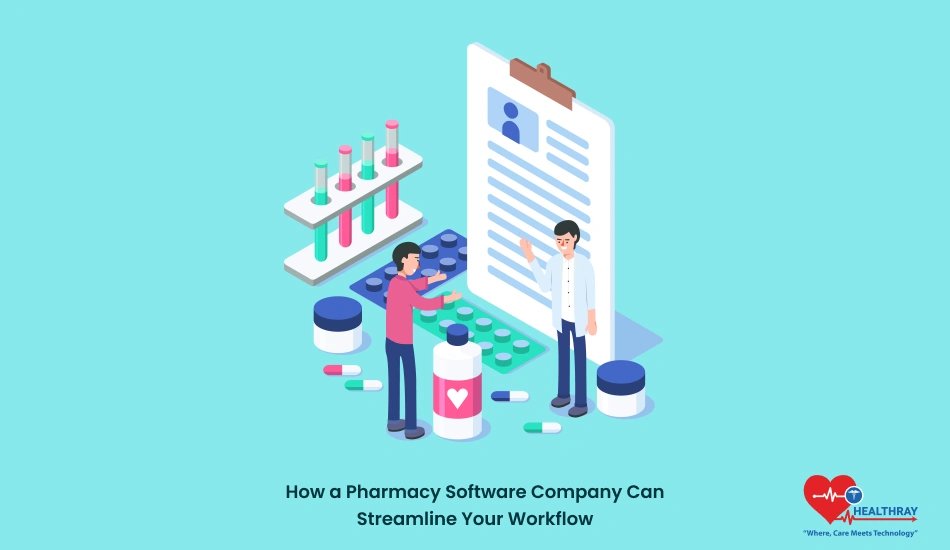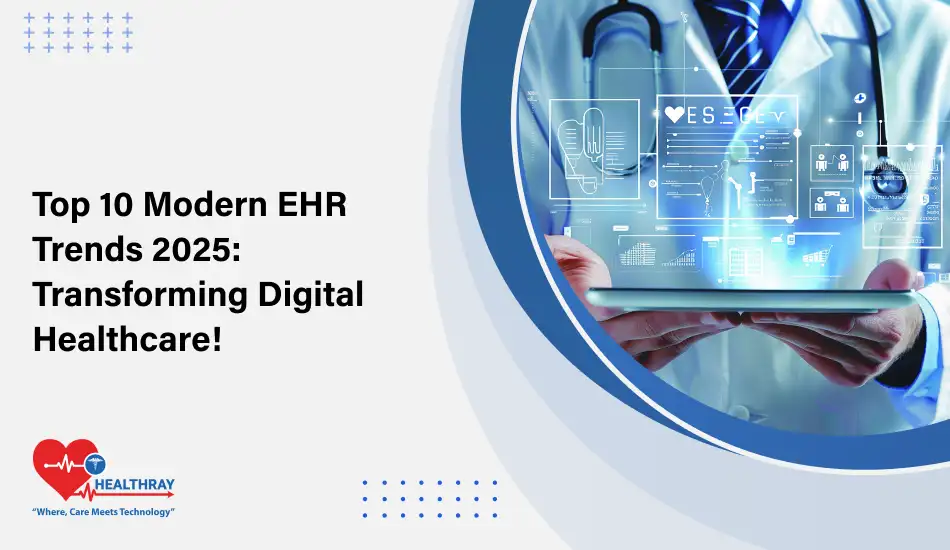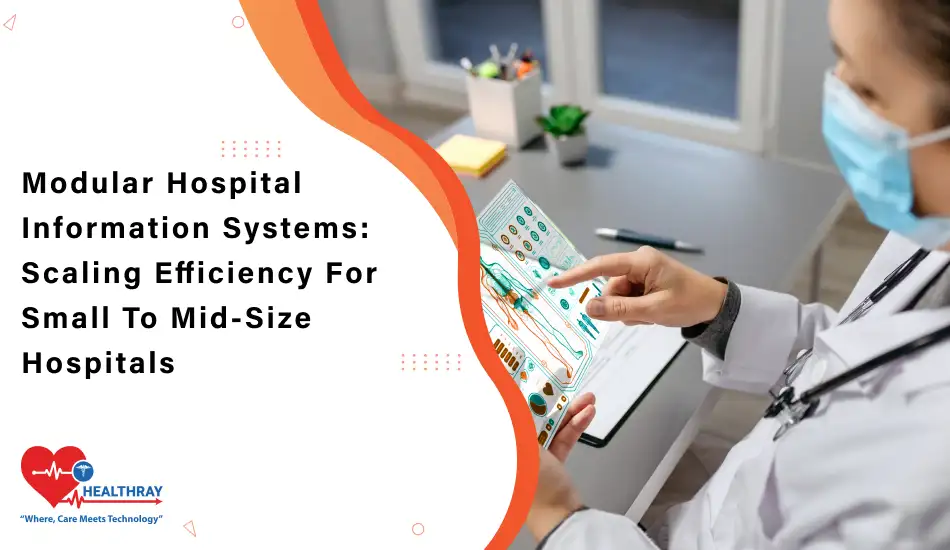Running a pharmacy isn’t just about filling prescriptions. It’s about juggling multiple roles—ensuring inventory is up to date, complying with regulations, and maintaining exceptional patient care. Sounds overwhelming, right? That’s where pharmacy software steps in.
Pharmacy software isn’t just a tool; it’s a game-changer for workflow optimization. It takes the chaos out of daily operations, automating repetitive tasks and freeing up time for what truly matters: patient outcomes and business growth.
This post explores how Pharmacy Management System companies can simplify operations, tailored to meet the needs of independent pharmacy owners, large chains, and healthcare administrators. We’ll dive into the features, benefits, and implementation strategies that can transform your pharmacy’s workflow.
Key Features of Pharmacy Software
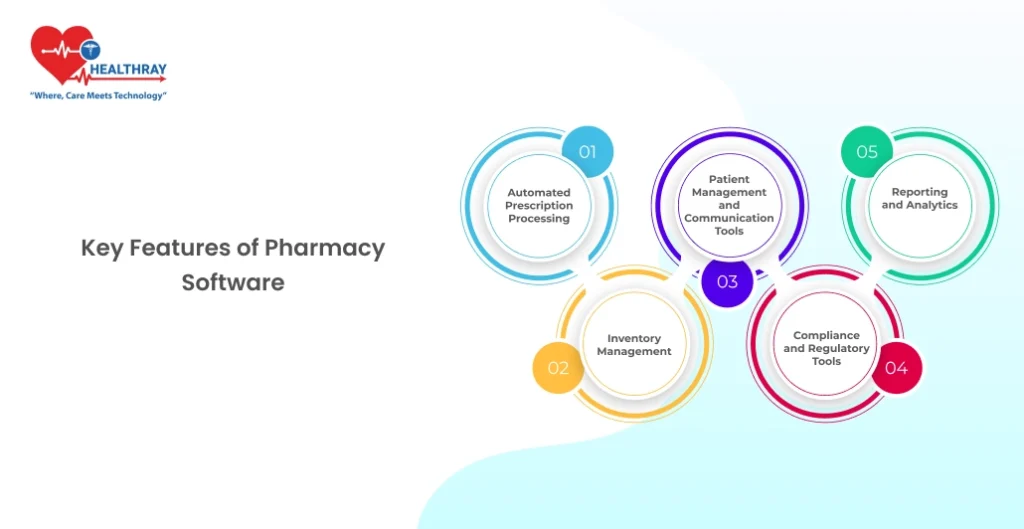
Pharmacy software is designed to handle the unique demands of pharmacy operations, making it an indispensable tool for improving efficiency and accuracy. Let’s explore the most impactful features that pharmacy owners, chain pharmacies, and healthcare administrators should look for.
Automated Prescription Processing
Manually managing prescriptions can be time-consuming and prone to errors. Pharmacy software automates this process by:
- Digitally scanning and processing prescriptions.
- Flagging potential drug interactions.
- Sending refill reminders to patients.
This automation not only speeds up prescription handling but also reduces errors, ensuring safer outcomes for patients.
Inventory Management
Stock management is crucial to avoid overstocking or running out of essential medications. Pharmacy software simplifies this by:
- Tracking real-time inventory levels.
- Sending alerts for low stock.
- Generating reports on fast-moving or slow-moving items.
For chain pharmacies, centralized inventory management becomes a breeze with these capabilities.
Patient Management and Communication Tools
Building strong relationships with patients is a cornerstone of pharmacy billing software success. With software tools, you can:
- Maintain comprehensive patient profiles.
- Send automated notifications for medication pickups and follow-ups.
- Offer online portals for patients to check prescriptions or request refills.
This creates a seamless experience, boosting patient satisfaction and loyalty.
Compliance and Regulatory Tools
Regulations in the healthcare industry are complex and ever-changing. Pharmacy software helps by:
- Keeping digital records that meet regulatory requirements.
- Offering features for e-prescriptions to comply with legal standards.
- Providing audit-ready reports for inspections.
Compliance becomes less of a headache, and you can focus more on running your business.
Reporting and Analytics
Insights into your pharmacy’s performance can guide better decisions. Advanced reporting features include:
- Daily sales and prescription trends.
- Inventory turnover rates.
- Patient behavior analysis.
Armed with data, you can identify growth opportunities and fine-tune your operations.
These features aren’t just bells and whistles. They form the backbone of a streamlined pharmacy workflow, no matter the scale of your operations. Next, we’ll look at how these benefits play out across different pharmacy settings.
Benefits for Different Pharmacy Settings
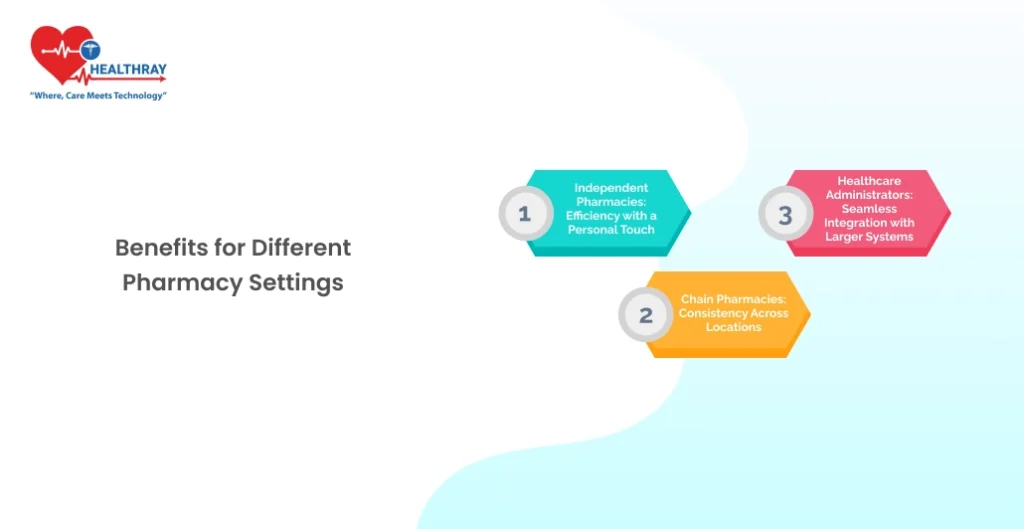
Pharmacy software solutions aren’t one-size-fits-all. Different types of pharmacies face unique challenges, and software adapts to meet those specific needs. Let’s break down how pharmacy owners, chain pharmacies, and healthcare administrators can reap the rewards of implementing this technology.
Independent Pharmacies: Efficiency with a Personal Touch
Independent pharmacies often struggle with limited staff and tight budgets. Pharmacy software helps by:
- Saving time: Automating tasks like prescription processing and billing allows pharmacists to focus more on patient care.
- Reducing errors: Built-in safety checks catch potential medication errors before they happen.
- Building loyalty: Features like refill reminders and patient profiles create a personalized experience for patients.
These tools allow independent pharmacies to deliver the care their communities rely on without getting bogged down by administrative tasks.
Chain Pharmacies: Consistency Across Locations
Chain pharmacies deal with the complexities of managing multiple branches. Pharmacy software provides:
- Centralized inventory management: Ensures that each location is stocked efficiently, reducing waste and shortages.
- Uniform processes: Standardized workflows across all stores maintain consistency in service quality.
- Scalable operations: The software grows with the business, easily adapting to new branches or increased prescription volumes.
By keeping operations smooth across the board, chain pharmacies can focus on scaling without sacrificing quality.
Healthcare Administrators: Seamless Integration with Larger Systems
Hospitals and healthcare systems have more intricate needs, often requiring integration with electronic health records (EHR) and other systems. Pharmacy software offers:
- EHR compatibility: Enables seamless sharing of patient data, ensuring continuity of care.
- Regulatory compliance tools: Keeps records audit-ready and in line with legal standards.
- Advanced analytics: Tracks trends in medication usage to inform policies and improve efficiency.
This level of integration allows healthcare administrators to oversee pharmacy operations as part of the broader healthcare ecosystem, ensuring every aspect runs smoothly.
Tailored benefits like these make pharmacy software indispensable for different settings. Whether you’re running a small community pharmacy or managing a large healthcare facility, the right software solution can align with your goals and challenges.
Integration and Implementation
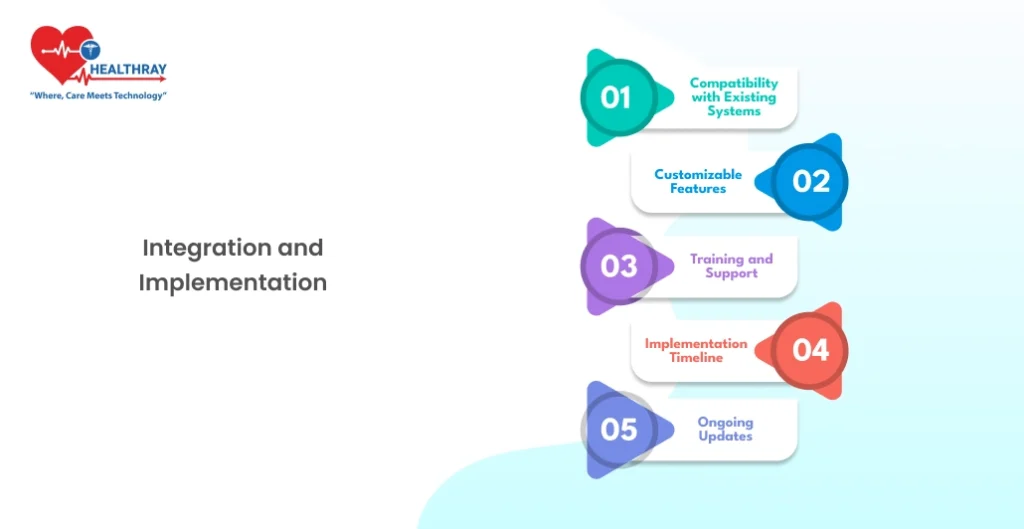
Switching to a PMS System might seem overwhelming, but with the right approach, it can be a smooth process. Understanding how software integrates with existing operations and planning the implementation carefully ensures minimal disruptions.
Compatibility with Existing Systems
Pharmacies often rely on multiple systems for billing, patient records, and inventory. Modern pharmacy software is designed to:
- Integrate seamlessly with point-of-sale systems, electronic health records (EHR), and supplier networks.
- Support data migration to consolidate records from older systems.
- Offer APIs for custom integrations, making it flexible for unique workflows.
Before choosing a solution, ensure it supports the systems you currently use.
Customizable Features
Every pharmacy is different. Pharmacy software allows customization to:
- Fit your workflow with tailored dashboards and features.
- Adjust user permissions based on roles within your team.
- Scale as your business grows, accommodating more locations or higher prescription volumes.
Customizability ensures that the software feels like a natural extension of your pharmacy.
Training and Support
The success of implementation heavily depends on how well your team adapts to the software. Most pharmacy software companies offer:
- Comprehensive training sessions to get your team up to speed.
- User-friendly interfaces that reduce the learning curve.
- Dedicated customer support to troubleshoot issues quickly.
Investing time in training ensures everyone on your team can use the software to its fullest potential.
Implementation Timeline
Transitioning to new software doesn’t happen overnight. A typical implementation plan includes:
- Initial consultation to understand your needs and design the system.
- Data migration phase for transferring records securely.
- Testing period to resolve bugs and ensure functionality.
- Go-live date, where the system is fully operational.
This phased approach minimizes disruptions and ensures a smoother transition.
Ongoing Updates
Pharmacy regulations and technology evolve quickly. Good pharmacy software providers offer:
- Regular updates to stay compliant with legal requirements.
- Feature enhancements to keep up with industry trends.
- Feedback channels so users can suggest improvements.
These updates help your system stay relevant and efficient over time.
Implementing pharmacy software doesn’t have to be daunting. By choosing a solution that integrates well, planning the transition carefully, and leveraging ongoing support, your pharmacy can unlock a new level of efficiency.
Cost and ROI
Investing in pharmacy software might seem like a big expense upfront, but the return on investment (ROI) often outweighs the costs. Let’s break down what you can expect to spend, the savings you’ll gain, and the overall financial impact.
Initial Investment
The upfront costs of pharmacy software vary based on the provider and the features you choose. Typically, these include:
- Software licensing fees: Often charged annually or monthly.
- Hardware costs: Such as scanners, tablets, or dedicated terminals.
- Implementation fees: Covering data migration, setup, and initial training.
Small pharmacies may spend less with basic solutions, while larger chains or hospitals might invest more in advanced features.
Ongoing Costs
Once the system is up and running, you’ll need to account for recurring expenses like:
- Subscription fees for software updates and support.
- Maintenance costs for hardware or IT services.
- Additional user licenses as your team grows.
Budgeting for these ensures uninterrupted operation.
Areas of Savings
Pharmacy software delivers savings that quickly offset costs. Major areas of cost reduction include:
- Labor efficiency: Automating tasks reduces the need for additional staff.
- Inventory control: Avoiding overstock and stockouts saves money.
- Error prevention: Reducing prescription errors minimizes costly corrections and legal risks.
- Improved patient retention: Enhanced customer service leads to repeat business and loyalty.
These savings can be significant, especially for larger operations.
Long-Term ROI
The benefits of pharmacy software extend beyond financial savings. Key ROI indicators include:
- Increased revenue: Faster prescription processing means serving more customers daily.
- Better decision-making: Analytics tools provide insights that help optimize operations.
- Compliance assurance: Avoiding penalties for non-compliance adds to your bottom line.
For example, a pharmacy processing 300 prescriptions daily could save hundreds of hours annually, translating directly to increased profitability.
Case Studies and Success Stories
Many pharmacies have seen measurable ROI after implementing software. Common results include:
- 30% faster prescription processing times.
- 20% reduction in inventory waste.
- Significant labor cost savings, allowing reinvestment in other areas.
These figures demonstrate how the right solution pays for itself over time.
By understanding the costs and focusing on the measurable benefits, pharmacy software becomes a smart investment for pharmacies of all sizes.
Compliance and Security
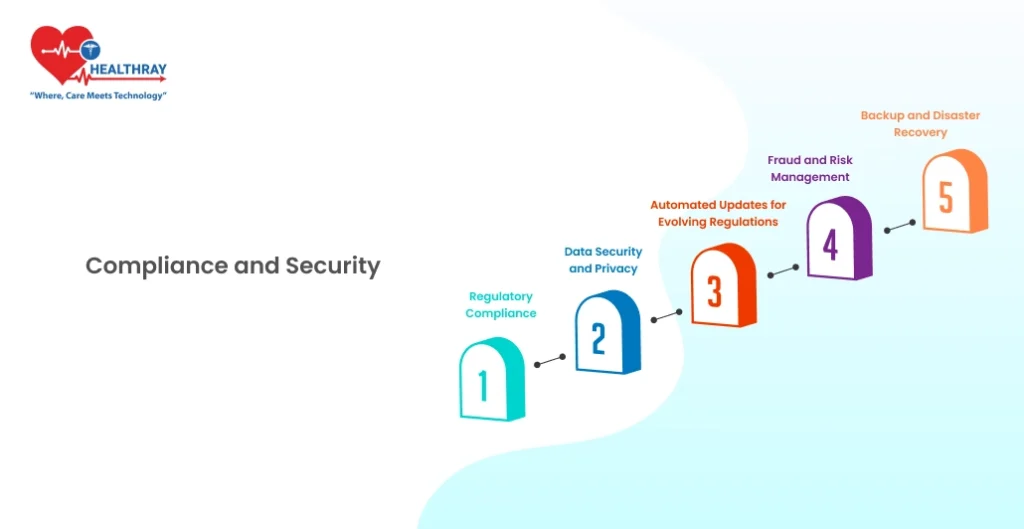
Pharmacies operate in a highly regulated environment, where compliance and security are critical. Pharmacy software is designed to help you stay compliant with industry standards while protecting sensitive patient and business data. Here’s how it ensures your operations are both lawful and secure.
Regulatory Compliance
Pharmacy software keeps your business aligned with the latest legal requirements. Features that support compliance include:
- Electronic prescribing (e-Prescriptions): Meets requirements for digital prescription transmission, reducing errors and enhancing record accuracy.
- Audit-ready reports: Automatically generates detailed documentation for inspections, saving time during audits.
- Controlled substance monitoring: Tracks and manages Schedule II-V substances to prevent misuse and ensure proper reporting.
By embedding compliance into daily operations, the software minimizes risks of fines or penalties.
Data Security and Privacy
Pharmacies handle sensitive patient data, making security a top priority. pharmacy management software solutions ensure:
- Encryption protocols to protect data during storage and transmission.
- Role-based access controls so only authorized staff can view sensitive information.
- HIPAA compliance to safeguard patient privacy and avoid breaches.
These measures build trust with patients while protecting your pharmacy from legal liabilities.
Automated Updates for Evolving Regulations
Healthcare regulations change frequently. Pharmacy software providers typically offer:
- Regular updates to incorporate new compliance standards.
- Real-time alerts for regulatory changes affecting your operations.
- On-demand support to answer compliance-related questions.
Staying updated ensures your pharmacy remains ahead of legal requirements.
Fraud and Risk Management
Fraud prevention is an essential aspect of security. Pharmacy software includes:
- Fraud detection tools that flag unusual activity, such as duplicate prescriptions.
- Tamper-proof records to ensure the integrity of patient and prescription data.
- Multi-factor authentication to verify user identities and prevent unauthorized access.
These tools reduce financial losses and improve the safety of your operations.
Backup and Disaster Recovery
In case of system failures or cyberattacks, pharmacy software often provides:
- Automated data backups to prevent loss of critical information.
- Disaster recovery solutions for restoring systems quickly with minimal downtime.
These features ensure your pharmacy can keep running, even during unforeseen events.
Compliance and security don’t just protect your business—they instill confidence in your customers and partners. With robust features built into pharmacy software, you can operate with peace of mind knowing your pharmacy meets the highest standards.
Conclusion
Pharmacy software is more than just a tool—it’s a lifeline for modern pharmacies aiming to streamline operations and improve patient care. Whether you’re an independent pharmacy owner, managing a chain, or part of a healthcare system, the benefits are undeniable.
From automating prescriptions and managing inventory to ensuring compliance and enhancing security, pharmacy software simplifies every aspect of pharmacy management. It saves time, reduces errors, and allows you to focus on what matters most—delivering quality care to your patients. The transition to Hospital Management System might seem challenging, but with customizable features, seamless integrations, and dedicated support, the rewards far outweigh the effort. By choosing the right solution and implementing it thoughtfully, you set your pharmacy up for sustained success and growth.
